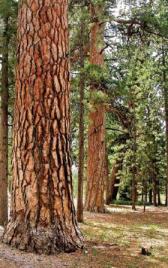
Throughout much of Eastern Washington, the ponderosa pine was the dominant tree species before Euro-American settlement. As DNR’s Identifying Old Trees and Forests in Eastern Washington describes, these trees were heavily logged after settlement because of their timber value. Early fire suppression efforts in forests also helped faster-growing and shade tolerant trees such as grand fir and Douglas-fir to crowd out the ponderosa pine. Here are a few facts about the ponderosa pine:
1. They are well suited to the patterns of low-severity wildfire that were once common through much of the West. Because the ponderosa pine sheds its lower branches as it grows and has thick bark, it would be relatively unscathed from fires that crept along the ground.
2. Ponderosa pine can grow in most areas of Eastern Washington, from rocky cliffs to along streams and rivers.
3. Because of different growing conditions, size is a hard way to judge the age of a ponderosa pine — a 30 inch-diameter tree in Eastern Washington could be 60 years old or 600 years.
4. The ponderosa pine is of vital use to tribes who have used its boughs, pitch and needles to produce medicine; its roots to make blue dye; needles for insulation and boards for construction.
5. The bark has a distinctive scent of vanilla or butterscotch.
Oh, and the ponderosa pine is one of the most distinctive trees of the western United States. Due to its commercial and habitat value, ponderosa pine is one of the several species grown and distributed by the DNR Webster Forest Nursery for replanting after timber harvests.